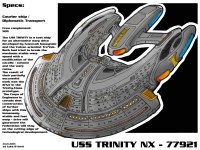
USS Trinity |
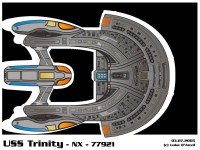
USS Trinity - Draufsicht |
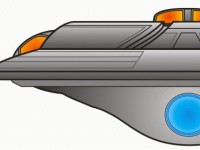
USS Trinity - Front Konzept |

USS Trinity - Emblem Konzept |
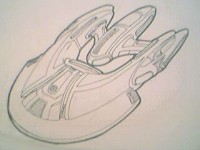
USS Trinity - Konzept |
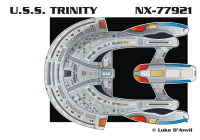
USS Trinity - Nemesis Revise |
Die Konstruktion der Trinity-Klasse ist ein Eingeständnis der Sternenflotte an den Dominion Krieg.
Während des Kriegsverlaufs wurde immer deutlicher, das die Föderation jedweden Alliierten brauchte, den sie bekommen konnte.
Ein Grundproblem war, das der Flotte oftmals nicht ausreichend verteidigte Kapazitäten zur Verfügung standen, um hochrangige Diplomaten zu wichtigen Brennpunkten der Allianzpolitik zu bringen. Waren Schiffe der Galaxy-Klasse in Kampfzonen nötiger gebraucht, waren Schiffe der Sabre-Klasse schlicht zu schlecht verteidigt und zu langsam.
Starfleet entschied, ein Theoretikum der Ingenieurin Ivanovah Kassynski und dem Vulkanier Tro'Vek zu realisieren. Die Warp-Ingenieurin und der Warptheoretiker hatten versucht, das Maximum der stabilen Warpskala durch eine Modifizierung des Gondel-Schemas und der Kerne zu erreichen.
Das Ergebnis ihrer teil-erfolgreichen Arbeit war der Antrieb im Trinity-Prototyp. Nachdem der zweite Warpkern in Betrieb genommen und erste EPS-Test erfolgreich abgeschlossen wurden, gab das Corps die Genehmigung für den Einbau der zwei sekundären Kerne. Die Rate der insgesamten Energieleistung konfrontierte die Ingenieure mit dem Problem instabiler Plasmaleitungen. Das Planungsbüro verstärkte die Leitungen und führte Verteilerknoten in das System ein. Abschließende Test liefen danach erfolgreich. Die Panzerung wurde zu 90 Prozent komplettiert und ein erster Testflug auf niedriger Geschwindigkeit unternommen.
Die Inbetriebnahme der mittleren, doppelkammrigen Warpgondel sorgte für die nötige Stabilität eines Hochgeschwindigkeits-Warpfeldes. Ist sie inaktiv, muss die Trinity auf herkömmliche Geschwindigkeiten zurückgreifen. Ein Nebeneffekt der dreifachen Kern-Konstruktion ist der hohe Energieoutput für die Waffensysteme. Das Schiff - obwohl herkömmlich bewaffnet - ist in der Lage, massiven Phaseroutput zu leisten und somit die Sicherheit der Diplomaten oder wichtiger Fracht zu garantieren.
Die Shuttlerampe liegt in der Frontsektion und trennt die zwei Haupt-VIP-Bereiche voneinander. Das Corps installierte acht Phaserbänke: Vier auf der Ober- und vier auf der Unterseite. Zusätzlich dazu wurfen vier Torpedowerfer integriert: Einer in jedem rückseitigen Pylon und zwei in der Untertassensektion.
Erst nach Beendigung des Dominionkrieges wurde die Testphase für die Trinity eingeleitet. Sie befindet sich momentan an einem unbekannten Verhandlungsort, um ein wichtiges Abkommen zu ermöglichen. Das Corpse ist sich einer Konstruktion weiterer Schiffe mit diesem immens stabilen und schnellen Warpantrieb sicher.
Ein Grundproblem war, das der Flotte oftmals nicht ausreichend verteidigte Kapazitäten zur Verfügung standen, um hochrangige Diplomaten zu wichtigen Brennpunkten der Allianzpolitik zu bringen. Waren Schiffe der Galaxy-Klasse in Kampfzonen nötiger gebraucht, waren Schiffe der Sabre-Klasse schlicht zu schlecht verteidigt und zu langsam.
Starfleet entschied, ein Theoretikum der Ingenieurin Ivanovah Kassynski und dem Vulkanier Tro'Vek zu realisieren. Die Warp-Ingenieurin und der Warptheoretiker hatten versucht, das Maximum der stabilen Warpskala durch eine Modifizierung des Gondel-Schemas und der Kerne zu erreichen.
Das Ergebnis ihrer teil-erfolgreichen Arbeit war der Antrieb im Trinity-Prototyp. Nachdem der zweite Warpkern in Betrieb genommen und erste EPS-Test erfolgreich abgeschlossen wurden, gab das Corps die Genehmigung für den Einbau der zwei sekundären Kerne. Die Rate der insgesamten Energieleistung konfrontierte die Ingenieure mit dem Problem instabiler Plasmaleitungen. Das Planungsbüro verstärkte die Leitungen und führte Verteilerknoten in das System ein. Abschließende Test liefen danach erfolgreich. Die Panzerung wurde zu 90 Prozent komplettiert und ein erster Testflug auf niedriger Geschwindigkeit unternommen.
Die Inbetriebnahme der mittleren, doppelkammrigen Warpgondel sorgte für die nötige Stabilität eines Hochgeschwindigkeits-Warpfeldes. Ist sie inaktiv, muss die Trinity auf herkömmliche Geschwindigkeiten zurückgreifen. Ein Nebeneffekt der dreifachen Kern-Konstruktion ist der hohe Energieoutput für die Waffensysteme. Das Schiff - obwohl herkömmlich bewaffnet - ist in der Lage, massiven Phaseroutput zu leisten und somit die Sicherheit der Diplomaten oder wichtiger Fracht zu garantieren.
Die Shuttlerampe liegt in der Frontsektion und trennt die zwei Haupt-VIP-Bereiche voneinander. Das Corps installierte acht Phaserbänke: Vier auf der Ober- und vier auf der Unterseite. Zusätzlich dazu wurfen vier Torpedowerfer integriert: Einer in jedem rückseitigen Pylon und zwei in der Untertassensektion.
Erst nach Beendigung des Dominionkrieges wurde die Testphase für die Trinity eingeleitet. Sie befindet sich momentan an einem unbekannten Verhandlungsort, um ein wichtiges Abkommen zu ermöglichen. Das Corpse ist sich einer Konstruktion weiterer Schiffe mit diesem immens stabilen und schnellen Warpantrieb sicher.
The construction of the Trinity-Class is a concession of Starfleet to the Dominion War. During the conflict the Federation realized that they needed every ally they could get.
The main problem was that the fleet often had only sufficient defense capabilities at their disposal in order to bring high-ranking diplomats to important political functions of the Alliance. While ships of the Galaxy-Class were more needed in the combat zone, Sabre-Class ships were simply too poorly defended and too slow.
Starfleet decided to explore a theory of the engineer Ivanovah Kassynski and the Vulcan scientist Tro'Vek. Both had tried to break the maximum stable warp speed with a modification of the nacelle-scheme and the warp cores.
The result of their partially successful work was the drive in the Trinity-Class prototype. After the primary warp core was installed and the first EPS tests were passed successfully, the Corps permitted the installation of the two secondary cores. The rate of the total energy output confronted the engineers with the problem of unstable plasma lines. The planning office strengthened the lines and introduced some distributor knots into the system. Further tests after that were successful. The armor was set up to 90 percent and a first interstellar flight at low speed was set to go.
The start-up of the center, double-chambered warp nacelle guaranteed the necessary stability of a high speed warpfield. If the nacelle is inactive, the Trinity must fall back to conventional speeds. A side effect of the triple core construction is the high energy output of the weapons systems. The ship, although armed conventionally, is able to generate massive phaser output and thus guarantees the security of the diplomats or important freight aboard.
The shuttlebay is located at the front. It seperates the two main VIP-areas. The Corps of Engineers installed eight phaser-stripe; four on top, four underneath. In addition four torpedo tubes were installed; one in each aft-pylon and two in the saucer.
It's a pity that the Trinity was introduced after the end of the Dominion War. It is momentarily at an unknown point in it's developement. The Corps of Engineers is certain that construction of further ships with this immensely stable and fast warp-drive will gaurantee the Federation will stay on the cutting edge of technological developement.
The main problem was that the fleet often had only sufficient defense capabilities at their disposal in order to bring high-ranking diplomats to important political functions of the Alliance. While ships of the Galaxy-Class were more needed in the combat zone, Sabre-Class ships were simply too poorly defended and too slow.
Starfleet decided to explore a theory of the engineer Ivanovah Kassynski and the Vulcan scientist Tro'Vek. Both had tried to break the maximum stable warp speed with a modification of the nacelle-scheme and the warp cores.
The result of their partially successful work was the drive in the Trinity-Class prototype. After the primary warp core was installed and the first EPS tests were passed successfully, the Corps permitted the installation of the two secondary cores. The rate of the total energy output confronted the engineers with the problem of unstable plasma lines. The planning office strengthened the lines and introduced some distributor knots into the system. Further tests after that were successful. The armor was set up to 90 percent and a first interstellar flight at low speed was set to go.
The start-up of the center, double-chambered warp nacelle guaranteed the necessary stability of a high speed warpfield. If the nacelle is inactive, the Trinity must fall back to conventional speeds. A side effect of the triple core construction is the high energy output of the weapons systems. The ship, although armed conventionally, is able to generate massive phaser output and thus guarantees the security of the diplomats or important freight aboard.
The shuttlebay is located at the front. It seperates the two main VIP-areas. The Corps of Engineers installed eight phaser-stripe; four on top, four underneath. In addition four torpedo tubes were installed; one in each aft-pylon and two in the saucer.
It's a pity that the Trinity was introduced after the end of the Dominion War. It is momentarily at an unknown point in it's developement. The Corps of Engineers is certain that construction of further ships with this immensely stable and fast warp-drive will gaurantee the Federation will stay on the cutting edge of technological developement.